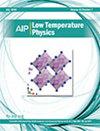Raman, UV-Vis, MS, and IR characterization of molecular-colloidal solution of hydrated fullerenes C60 obtained using vacuum-sublimation cryogenic deposition method. Is the C60 molecule truly highly hydrophobic?
IF 0.8
4区 物理与天体物理
Q4 PHYSICS, APPLIED
引用次数: 0
Abstract
Vacuum-sublimation cryogenic deposition (VS-CD) method is successfully applied to produce fullerene water colloidal solution (FWCS): the melting of the solid phase of the mixture obtained by joint condensation of C60 fullerene and water vapors onto a surface cooled with liquid nitrogen results in formation of a stable colloidal solution. The results of the FWCS characterization by means of Raman, IR, and UV-Vis spectroscopy and their comparison with known literature data on hydrated fullerenes give the authors an opportunity to make conclusion that the FWCS contains C60@{H2O}n complexes of hydrated C60 fullerene. Transmission electron microscopy shows that the VS-CD-produced material contains predominantly small C60 clusters of about 2–5 nm size, while mass spectrometry with laser desorption/ionization has demonstrated the presence of pure fullerene C60 and the absence of any products of its transformation. The performed analysis reveals a close similarity of the stable C60@{H2O}n complexes generated by VS-CD with the previously known highly hydrophilic hydrated fullerene obtained by ultrasonication method.利用真空升华低温沉积法获得的水合富勒烯 C60 分子胶体溶液的拉曼、紫外可见光、质谱和红外特性。C60 分子是否真的高度疏水?
真空升华低温沉积(VS-CD)方法被成功应用于富勒烯水胶体溶液(FWCS)的制备:通过将 C60 富勒烯和水蒸气共同凝结在液氮冷却的表面上而获得的混合物固相熔化,从而形成稳定的胶体溶液。通过拉曼光谱、红外光谱和紫外可见光谱对 FWCS 进行表征,并将其与已知的水合富勒烯文献数据进行比较,作者得出结论:FWCS 中含有水合 C60 富勒烯的 C60@{H2O}n 复合物。透射电子显微镜显示,VS-CD 生成的材料主要含有尺寸约为 2-5 纳米的小 C60 簇,而激光解吸/电离质谱则证明了纯富勒烯 C60 的存在,且不含任何其转化产物。分析结果表明,VS-CD 生成的稳定 C60@{H2O}n 复合物与之前通过超声法获得的已知高亲水性水合富勒烯非常相似。
本文章由计算机程序翻译,如有差异,请以英文原文为准。
求助全文
约1分钟内获得全文
求助全文
来源期刊

Low Temperature Physics
物理-物理:应用
CiteScore
1.20
自引率
25.00%
发文量
138
审稿时长
3 months
期刊介绍:
Guided by an international editorial board, Low Temperature Physics (LTP) communicates the results of important experimental and theoretical studies conducted at low temperatures. LTP offers key work in such areas as superconductivity, magnetism, lattice dynamics, quantum liquids and crystals, cryocrystals, low-dimensional and disordered systems, electronic properties of normal metals and alloys, and critical phenomena. The journal publishes original articles on new experimental and theoretical results as well as review articles, brief communications, memoirs, and biographies.
Low Temperature Physics, a translation of the copyrighted Journal FIZIKA NIZKIKH TEMPERATUR, is a monthly journal containing English reports of current research in the field of the low temperature physics. The translation began with the 1975 issues. One volume is published annually beginning with the January issues.
 求助内容:
求助内容: 应助结果提醒方式:
应助结果提醒方式:


